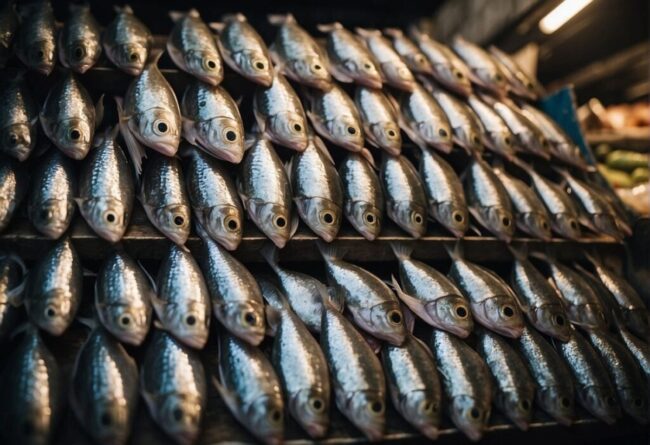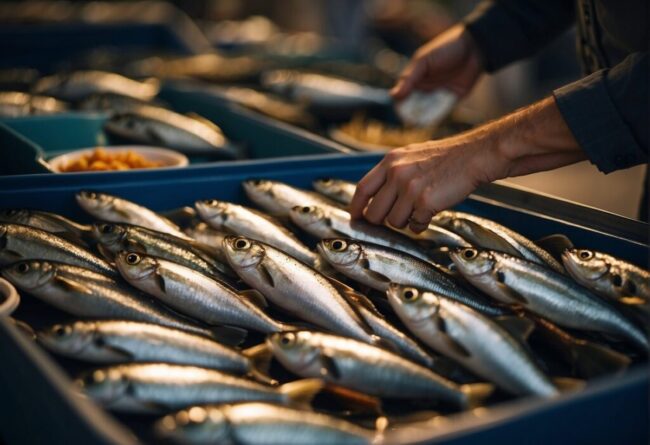6 Delicious Swaps for Mackerel in Recipes
Mackerel substitutes bring a deep, oceanic flavor to your plate when this oily fish is absent.
An array of marine alternatives captures the robust, slightly smoky character that defines mackerel.
Seafood dishes retain a hearty taste and satisfying texture that echo the mysteries of the deep.
Every serving exudes a comforting warmth tied to coastal traditions and fresh, bold flavors.
What to Know About Mackerel
Mackerel is a fatty fish rich in omega-3 fatty acids and has a distinct, bold flavor. It is commonly grilled, smoked, or used in sushi.
Food Nutrition Facts
Mackerel serves as a powerhouse of nutrition, packed with omega-3 fatty acids that support heart and brain function.
This fish provides a substantial amount of protein, essential for tissue repair and growth.
With vitamin D in the mix, it aids in maintaining strong bones while boosting immune responses.
Rich in calcium, mackerel contributes significantly to dental health and overall bone integrity.
Selenium acts as a protective antioxidant within your cells, further enhancing the nutritional profile of this remarkable fish.
Cooking Applications
Mackerel shines in the kitchen with its robust taste, making it a versatile choice for many cooking styles.
Grilling, baking, or pan-frying highlights its unique flavor profile beautifully.
The zest of lemon cuts through the richness and elevates each bite to new heights.
Olive oil serves as a healthy base while introducing gentle notes that harmonize perfectly with this fish.
A sprinkle of salt unlocks the inherent flavors, inviting you to explore various culinary adventures at home.
Nature Worries
Mackerel populations face challenges due to unsustainable fishing methods, particularly in the Gulf of Mexico and parts of the Western Atlantic.
Overfishing threatens these vital stocks, impacting marine ecosystems and local economies.
Choosing sustainably caught mackerel helps protect these fish for future generations.
Norway and the United States lead in responsible fishing practices, especially for Atlantic mackerel.
Supporting sustainable sources not only promotes healthier oceans but also ensures that this nutritious fish remains available on your plate.
Health Factors to Consider
Mackerel shines as a powerhouse of nutrition, packed with omega-3 fatty acids that promote heart wellness and reduce inflammation.
Not all mackerel are created equal; some varieties harbor lower mercury levels, making them safer choices for those expecting or nursing.
Selecting the right type can significantly enhance your dietary benefits while minimizing potential risks.
This fish not only supports brain health but also contributes to overall well-being through its rich vitamin D content.
Always pay attention to where your fish comes from and choose wisely for a healthier lifestyle.
Alternatives to Mackerel Fish
Mackerel fish offers a rich flavor and healthy omega-3 fats. Various alternatives provide similar taste profiles and nutritional benefits, making them great substitutes in recipes.
Tuna
Tuna serves as a fantastic alternative to mackerel with its robust and savory taste.
The texture is hearty, making it satisfying in various dishes.
Packed with protein and omega-3 fatty acids, this fish contributes significantly to a healthy diet.
Versatile in the kitchen, tuna works well in salads, sandwiches, or even grilled on its own.
Choosing tuna not only enhances meals but also supports overall well-being through its nutritional benefits.
Salmon
Salmon offers a rich, buttery flavor that many find irresistible.
This fish is packed with omega-3 fatty acids, essential for heart health and brain function.
Its versatility allows it to shine in various dishes, from salads to pastas.
When looking for alternatives to mackerel, salmon provides a similar oily texture that enhances any meal.
Using salmon can elevate your culinary creations while also promoting well-being through its nutritious profile.
Herring and Sardines
Herring and sardines offer a delightful alternative to mackerel, showcasing their own distinct qualities.
These smaller fish deliver a rich, savory flavor that many find appealing.
Often found in convenient canned or smoked forms, they make for effortless meal additions.
Their impressive omega-3 content contributes to heart health and overall wellness.
Enjoying herring or sardines can elevate your dishes while providing essential nutrients in every bite.
White-Fleshed Fish
White-fleshed fish presents a wonderful option for those who enjoy lighter flavors.
Cod, halibut, and sea bass each offer a delicate taste that complements various culinary styles.
Their flaky texture allows them to absorb marinades and spices easily, creating diverse meal experiences.
Cooking with these fish can be an adventure in the kitchen as they adapt beautifully to both simple preparations or more elaborate dishes.
When you seek versatility on your plate, these options shine brightly among seafood choices.
More Fatty Fish
Fatty fish such as swordfish, mahi mahi, and bluefish deliver a satisfying richness that many seafood lovers appreciate.
Trout presents a lighter alternative with its delicate taste and versatile texture.
Each of these options can elevate your meals in surprising ways.
Cooking them can open up exciting culinary experiences in your kitchen.
Exploring different preparations will enhance your enjoyment of these delicious catches from the sea.
Local and Eco-Friendly Choices
Sustainability in seafood choices opens up a world of delicious options.
Spanish mackerel and American shad shine as regional favorites, providing unique flavors that elevate any dish.
Caught from the Gulf of Mexico or Alaska, these fish not only support local economies but also promote eco-friendly practices.
Their distinct textures can easily replace traditional Atlantic mackerel in recipes, enhancing your meals with variety.
Choosing these species means enjoying great taste while being kind to the planet; it’s a win-win for your plate and the environment!
Tips for Choosing Substitutes for Mackerel
You can based on several factors to pick the besy mackerel replacements.
By Taste Type
Finding the perfect fish to echo mackerel's rich flavor can lead you to some delightful alternatives.
American shad stands out with its oily texture and salty essence, blending beautifully with zesty lemon juice or tangy mustard.
Bold seasonings like pepper and parsley add a punch that pairs wonderfully with this fish.
Spanish mackerel offers a subtler option, allowing for versatility in cooking methods; olive oil and butter elevate its taste when crafting sweet sauces.
Exploring these options opens up an exciting culinary journey filled with flavor exploration!
Based on Nutrition Value
Fish can be a powerhouse of nutrition, offering essential omega-3 fatty acids and high-quality protein.
Tuna stands out for its impressive protein levels, making it a popular choice among health-conscious eaters.
This fish also contains vitamin D, which supports bone health and immune function.
Many appreciate how tuna provides B vitamins that contribute to energy production and overall well-being.
Choosing tuna not only satisfies your taste buds but also supports your nutritional needs effectively.
By Feel
Mackerel offers a distinct flaky texture that is both satisfying and rich.
If you're looking for alternatives that capture this essence, tuna stands out with its robust consistency.
This fish holds up well in various cooking methods, whether grilled to perfection or incorporated into a hearty stew.
Other options like salmon also provide a pleasing texture while delivering their own unique flavor profiles.
Experimenting with different fish can open doors to delightful meals that keep your taste buds intrigued.
Cooking Techniques Explained
Cooking methods play a crucial role in highlighting the natural flavors of fish.
When choosing substitutes like mackerel for grilling, seasoning is essential, along with preheating your grill to medium-high heat.
Different techniques suit various alternatives; frying or oven-roasting requires specific times and temperatures to achieve optimal taste and texture.
A well-oiled grill grate prevents sticking, ensuring that each piece cooks evenly without losing its appeal.
Adjusting your approach according to the type of fish can lead you to a truly satisfying culinary experience.
How to Prepare Mackerel Substitutes
Preparing mackerel substitutes requires adjusting cooking times based on fat content. Options like salmon or bluefish can be used in similar recipes.
Grilling Methods
Grilling offers a fantastic way to elevate the flavors of substitutes like sardines or American shad.
A preheated grill at medium-high heat creates the ideal environment for a perfect sear.
Cleaning the grill grate ensures that those tasty morsels won’t stick, allowing for an effortless cooking experience.
Lightly oiling the fish not only adds moisture but also enhances its texture during grilling.
Cooking time ranges from three to four minutes per side, depending on how thick your fish is; just keep an eye on it for that delicious finish!
Baking and Frying Basics
Baking or pan-frying substitutes can replicate the rich taste and texture of mackerel beautifully.
Start by preheating your oven to 350°F (175°C) for baking, ensuring a perfectly cooked dish.
When frying, choose a non-stick pan and add just a touch of olive oil or butter for flavor.
Seasoning with salt and pepper enhances the natural flavors before cooking begins.
Cook times differ; generally, aim for about 10 minutes per inch when baking or 3-5 minutes on each side when frying to achieve that ideal doneness.
Making Tasty Marinades
Marinades hold the secret to elevating your meals.
They create a wonderful blend of flavors that can transform any dish into something special.
With a mix of olive oil, an acidic element like lemon juice or vinegar, and seasonings such as salt and pepper, you craft the perfect base for marinating.
Adding herbs like fennel introduces layers of complexity that excite the palate in unexpected ways.
After letting fish soak up those delightful flavors for 20-30 minutes, you’ll taste how simple ingredients can work together to create magic on your plate.
How to Serve
Elevating a dish can be as easy as choosing the right sides.
Rice and salad serve as fantastic companions, adding freshness without overshadowing the main event.
A drizzle of olive oil and a squeeze of lemon brightens everything up just before it hits the table.
Think about how textures interact; pairing crisp vegetables with oily fish creates an appealing contrast that excites the palate.
These simple choices enhance your meal, making each bite feel balanced and satisfying.



